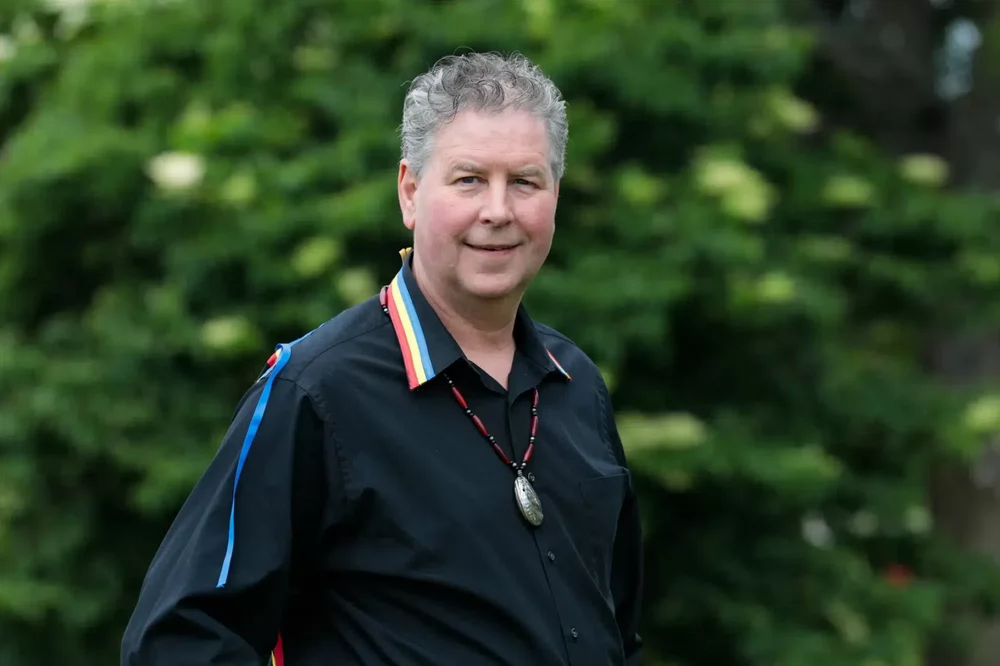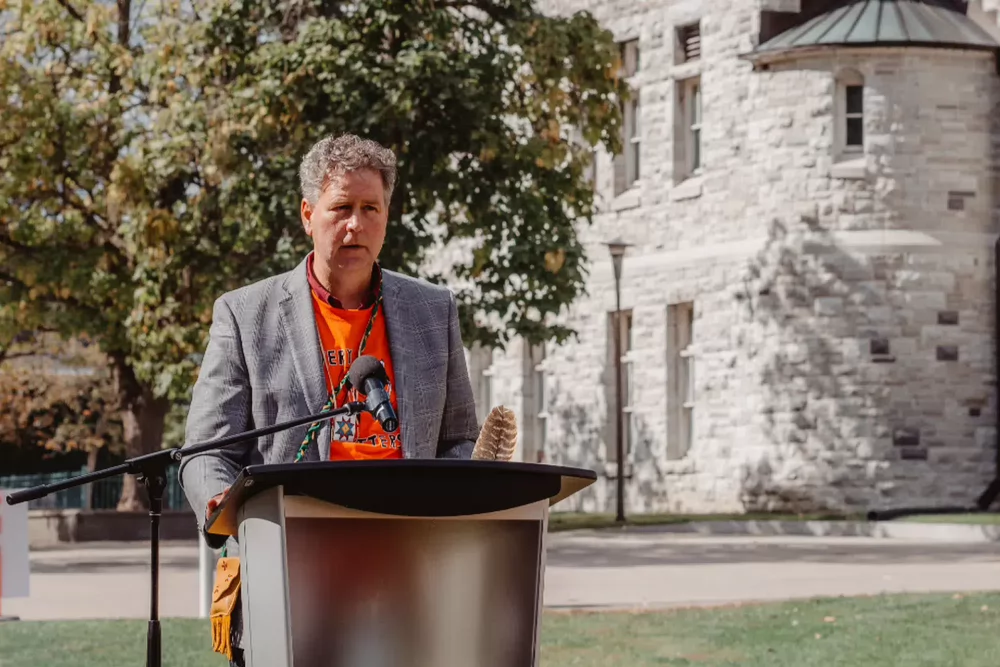
Dr. Mark Green (Civil Engineering), NSERC Scholar in Residence for Indigenous collaboration [Credit: NSERC]
It’s been one year since the Natural Sciences and Engineering Research Council of Canada (NSERC) welcomed Rahswahérha Mark Green (Civil Engineering) in the advisory position of Scholar in Residence for Indigenous collaboration. Since his appointment, Dr. Green has been providing NSERC with unique and novel viewpoints from an Indigenous researcher perspective and valuable advice on policies and programming options that have an impact on Canada’s engineering community.
To mark the halfway point of his term as NSERC Scholar in Residence, we had an engaging conversation with Dr. Green to explore his career and hear more about his invaluable experiences working alongside and advocating for Indigenous communities in the research ecosystem.
Could you tell us the story of what led you to civil engineering?
I was particularly interested in mathematics and science growing up. When it came time to choose a path in high school, my dad said, “Well, why don't you consider engineering?” My dad was a math teacher, and two of my uncles were engineers, which is unusual for First Nations people because there are not that many First Nations engineers. Having these role models made the choice to go into engineering seem like a good option. Then, in choosing a discipline, I was drawn towards things that I could lay my hands on. I was interested in structures and had enjoyed my experience of building a cabin with my dad in high school. That's why I went into civil engineering.
Funded by NSERC’s Collaborative Research and Training Experience (CREATE) program, you led the Sustainable Engineering in Remote Areas (SERA) program from 2013 to 2019. What was the goal of the program?
I was always quite involved in Indigenous activities. I was an advisor to the Dean of Engineering and Applied Science on the development of Indigenous Futures in Engineering, and I served as Co-Chair of the Aboriginal Council of Queen’s University. I was doing these activities separately from my research, and I thought there might be a way to bring them together. That’s when I had the idea of bringing some of the work that I was doing in advancing Indigenous Peoples in education into my research program.
When we started, we had two main research goals: housing and sustainable energy. We wanted to undertake outstanding research and transfer the technologies we developed to industry partners and Indigenous communities. The third goal was a training objective: to involve more Indigenous Peoples in the research and to engage more with Indigenous communities.

Dr. Mark Green discusses the generational effects of residential schools on Indigenous families and communities and speaks candidly of his own family's connection to the system during a gathering on campus in recognition of the National Day for Truth and Reconciliation in 2021.
What were the challenges you had to overcome?
There were challenges in First Nations communities, particularly in Northern and remote areas, with regard to energy, many relying upon diesel for electricity locally. We wanted to look at sustainable alternatives. We recognized that, generally, engineers didn’t know much about Indigenous Peoples. We knew that engineers and other scientists had to learn more about First Nations Peoples if they were going to work together in a good way. A big part of the CREATE program was about training and developing best practices to work together.
There were also financial barriers for Indigenous students participating in research programs, especially in the summer. To overcome this barrier, we increased the funding available to students considerably to make it more comparable to industry positions they might be able to get in the summer.
The SERA program trained seven postdoctoral trainees, 37 graduate students and 16 undergraduate students, including 19 Indigenous students, in both cutting-edge research and an understanding of Indigenous culture. Do you have examples of the lasting impact of this program?
We developed a graduate course that all students who participated in the SERA program took. About a third of the course was about Indigenous issues and learning about the histories of Indigenous Peoples, the ceremonies and the best ways to work with communities. There were various opportunities to learn in experiential ways, such as participating in a sweat lodge and challenging science and engineering students to write reflection pieces on their experiences. This was quite different than many other STEM-related graduate courses, and that course has continued.
Involving Indigenous students in the research was very successful, particularly at the undergraduate level. Most of them were undergraduate students who participated in summer or even term research opportunities with us. Many of them have done well and have gone on to work for Indigenous engineering firms. We have certainly learned a lot of best practices from engaging and doing research directly with Indigenous communities.
Building on my interest and expertise in fire engineering, I'm currently working with some First Nations communities to enhance their resilience to forest fires. I continue to implement some of the best practices gained from the SERA program.
How has your learning continued since you started the SERA program?
I learned more about our own ceremonies through the program. I always had some involvement with our own community, but I became more involved with our Longhouse and was invited to a ceremony where I received my Kanyen'kéha name of Rahswahérha (he builds a bridge). Through those experiences, I’ve gained more confidence in the SERA course and I have been doing more self-education along the way. I’ve been a student myself in the last few years with a collaborative language and cultural program that Queen’s has with our local language centre, Tsi Tyónnheht Onkwawén:na. That experience has given more understanding of the importance of languages from a practical perspective, as well as some different insights into the culture. It was an interesting experience as an educator learning in a formal setting. It helped me be more in tune with how students are learning.
You were appointed NSERC Scholar in Residence in 2023. Can you tell us more about what you are hoping to achieve and where you feel you can make a difference?
In my role as Scholar in Residence, I want to help develop and maintain good support systems for Indigenous undergraduate and graduate students, and postdoctoral fellows who are involved in research. I am working on policies for Indigenous research, particularly best practices for research with First Nations and Inuit and Métis communities. I can also leverage my experiences with Indigenous organizations to offer context, better support and engage students and other highly qualified personnel in the process. I aim to enhance awareness within NSERC by providing support for the Indigenous Employee Network and by participating in educational opportunities such as internal staff events and this research story.
Mark Green is a professor in the Department of Civil Engineering at Queen’s University, NSERC Scholar in Residence, and a member of the Mohawks of the Bay of Quinte. He was also an advisor to the Dean of Engineering and Applied Science on the development of Indigenous Futures in Engineering, Provost and Vice-Principal Academic at Queen’s University, and served as Co-chair of the Aboriginal Council of Queen’s University and as Chair of the First Nations Technical Institute. Read more about what his team accomplished with the CREATE Sustainable Engineering in Remote Areas (SERA) program.
This article originally appeared in the Natural Sciences and Engineering Research Council of Canada's Impact Stories series.